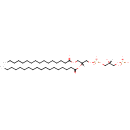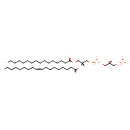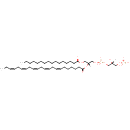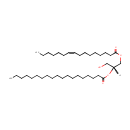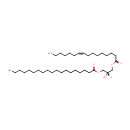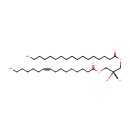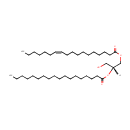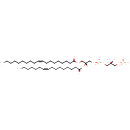
Search Results for compounds
Searching compounds for
returned 4373 results.
Displaying compounds 2191 - 2200 of
4373 in total
PGP(16:0/18:0) (PAMDB006277)
IUPAC:
[(2R)-3-({[(2R)-3-(hexadecanoyloxy)-2-(octadecanoyloxy)propoxy](hydroxy)phosphoryl}oxy)-2-hydroxypropoxy]phosphonic acid
CAS: Not Available
Description: PGP(16:0/18:0) belongs to the class of glycerophosphoglycerophosphates, also called phosphatidylglycerophosphates (PGPs). These lipids contain a common glycerophosphate skeleton linked to at least one fatty acyl chain and a glycero-3-phosphate moiety. As is the case with diacylglycerols, phosphatidylglycerophosphates can have many different combinations of fatty acids of varying lengths and saturation attached to the C-1 and C-2 positions. PGP(16:0/18:0), in particular, consists of one hexadecanoyl chain to the C-1 atom, and one octadecanoyl to the C-2 atom. In Pseudomonas aeruginosa, PGPs can be found in the cytoplasmic membrane. The are synthesized by the addition of glycerol 3-phosphate to a CDP-diacylglycerol. In turn, PGPs are dephosphorylated to Phosphatidylglycerols (PGs) by the enzyme Phosphatidylglycerophosphatase.
PGP(16:0/18:1(11Z)) (PAMDB006278)
IUPAC:
[(2R)-3-({[(2R)-3-(hexadecanoyloxy)-2-[(11Z)-octadec-11-enoyloxy]propoxy](hydroxy)phosphoryl}oxy)-2-hydroxypropoxy]phosphonic acid
CAS: Not Available
Description: PGP(16:0/18:1(11Z)) belongs to the class of glycerophosphoglycerophosphates, also called phosphatidylglycerophosphates (PGPs). These lipids contain a common glycerophosphate skeleton linked to at least one fatty acyl chain and a glycero-3-phosphate moiety. As is the case with diacylglycerols, phosphatidylglycerophosphates can have many different combinations of fatty acids of varying lengths and saturation attached to the C-1 and C-2 positions. PGP(16:0/18:1(11Z)), in particular, consists of one hexadecanoyl chain to the C-1 atom, and one 11Z-octadecenoyl to the C-2 atom. In Pseudomonas aeruginosa, PGPs can be found in the cytoplasmic membrane. The are synthesized by the addition of glycerol 3-phosphate to a CDP-diacylglycerol. In turn, PGPs are dephosphorylated to Phosphatidylglycerols (PGs) by the enzyme Phosphatidylglycerophosphatase.
PGP(16:0/18:1(9Z)) (PAMDB006279)
IUPAC:
[(2R)-3-({[(2R)-3-(hexadecanoyloxy)-2-[(9Z)-octadec-9-enoyloxy]propoxy](hydroxy)phosphoryl}oxy)-2-hydroxypropoxy]phosphonic acid
CAS: Not Available
Description: PGP(16:0/18:1(9Z)) belongs to the class of glycerophosphoglycerophosphates, also called phosphatidylglycerophosphates (PGPs). These lipids contain a common glycerophosphate skeleton linked to at least one fatty acyl chain and a glycero-3-phosphate moiety. As is the case with diacylglycerols, phosphatidylglycerophosphates can have many different combinations of fatty acids of varying lengths and saturation attached to the C-1 and C-2 positions. PGP(16:0/18:1(9Z)), in particular, consists of one hexadecanoyl chain to the C-1 atom, and one 9Z-octadecenoyl to the C-2 atom. In Pseudomonas aeruginosa, PGPs can be found in the cytoplasmic membrane. The are synthesized by the addition of glycerol 3-phosphate to a CDP-diacylglycerol. In turn, PGPs are dephosphorylated to Phosphatidylglycerols (PGs) by the enzyme Phosphatidylglycerophosphatase.
PGP(16:0/22:5(7Z,10Z,13Z,16Z,19Z)) (PAMDB006280)
IUPAC:
[(2R)-3-({[(2R)-2-[(7Z,10Z,13Z,16Z,19Z)-docosa-7,10,13,16,19-pentaenoyloxy]-3-(hexadecanoyloxy)propoxy](hydroxy)phosphoryl}oxy)-2-hydroxypropoxy]phosphonic acid
CAS: Not Available
Description: PGP(16:0/22:5(7Z,10Z,13Z,16Z,19Z)) belongs to the class of glycerophosphoglycerophosphates, also called phosphatidylglycerophosphates (PGPs). These lipids contain a common glycerophosphate skeleton linked to at least one fatty acyl chain and a glycero-3-phosphate moiety. As is the case with diacylglycerols, phosphatidylglycerophosphates can have many different combinations of fatty acids of varying lengths and saturation attached to the C-1 and C-2 positions. PGP(16:0/22:5(7Z,10Z,13Z,16Z,19Z)), in particular, consists of one hexadecanoyl chain to the C-1 atom, and one 7Z,10Z,13Z,16Z,19Z-docosapentaenoyl to the C-2 atom. In Pseudomonas aeruginosa, PGPs can be found in the cytoplasmic membrane. The are synthesized by the addition of glycerol 3-phosphate to a CDP-diacylglycerol. In turn, PGPs are dephosphorylated to Phosphatidylglycerols (PGs) by the enzyme Phosphatidylglycerophosphatase.
DG(16:1(9Z)/0:0/19:0) (PAMDB006454)
IUPAC:
(2R)-1-[(9Z)-hexadec-9-enoyloxy]-3-hydroxypropan-2-yl nonadecanoate
CAS: Not Available
Description: DG(16:1(9Z)/0:0/19:0) belongs to the family of Diacylglycerols. These are glycerolipids lipids containing a common glycerol backbone to which at least one fatty acyl group is esterified. It is involved in the phospholipid metabolic pathway.
DG(16:1(9Z)/19:0/0:0) (PAMDB006455)
IUPAC:
(2R)-3-[(9Z)-hexadec-9-enoyloxy]-2-hydroxypropyl nonadecanoate
CAS: Not Available
Description: DG(16:1(9Z)/19:0/0:0) belongs to the family of Diacylglycerols. These are glycerolipids lipids containing a common glycerol backbone to which at least one fatty acyl group is esterified. DG(16:1(9Z)/19:0/0:0) is also a substrate of diacylglycerol kinase. It is involved in the phospholipid metabolic pathway.
DG(17:0/16:1(9Z)/0:0) (PAMDB006456)
IUPAC:
(2S)-3-[(9Z)-hexadec-9-enoyloxy]-2-hydroxypropyl heptadecanoate
CAS: Not Available
Description: DG(17:0/16:1(9Z)/0:0) belongs to the family of Diacylglycerols. These are glycerolipids lipids containing a common glycerol backbone to which at least one fatty acyl group is esterified. DG(17:0/16:1(9Z)/0:0) is also a substrate of diacylglycerol kinase. It is involved in the phospholipid metabolic pathway.
DG(18:1(11Z)/0:0/18:0) (PAMDB006458)
IUPAC:
(2R)-3-hydroxy-2-(octadecanoyloxy)propyl (11Z)-octadec-11-enoate
CAS: Not Available
Description: DG(18:1(11Z)/0:0/18:0) belongs to the family of Diacylglycerols. These are glycerolipids lipids containing a common glycerol backbone to which at least one fatty acyl group is esterified. It is involved in the phospholipid metabolic pathway.
PGP(19:1(9Z)/16:1(9Z)) (PAMDB006647)
IUPAC:
[(2R)-3-({[(2R)-2-[(9Z)-hexadec-9-enoyloxy]-3-[(9Z)-nonadec-9-enoyloxy]propoxy](hydroxy)phosphoryl}oxy)-2-hydroxypropoxy]phosphonic acid
CAS: Not Available
Description: PGP(19:1(9Z)/16:1(9Z)) belongs to the class of glycerophosphoglycerophosphates, also called phosphatidylglycerophosphates (PGPs). These lipids contain a common glycerophosphate skeleton linked to at least one fatty acyl chain and a glycero-3-phosphate moiety. As is the case with diacylglycerols, phosphatidylglycerophosphates can have many different combinations of fatty acids of varying lengths and saturation attached to the C-1 and C-2 positions. PGP(19:1(9Z)/16:1(9Z)), in particular, consists of one 9Z-nonadecenoyl chain to the C-1 atom, and one 9Z-hexadecenoyl to the C-2 atom. In Pseudomonas aeruginosa, PGPs can be found in the cytoplasmic membrane. The are synthesized by the addition of glycerol 3-phosphate to a CDP-diacylglycerol. In turn, PGPs are dephosphorylated to Phosphatidylglycerols (PGs) by the enzyme Phosphatidylglycerophosphatase.
PGP(19:iso/10:0(3-OH)) (PAMDB006649)
IUPAC:
Not Available
CAS: Not Available
Description: PGP(19:iso/10:0(3-OH)) belongs to the class of glycerophosphoglycerophosphates, also called phosphatidylglycerophosphates (PGPs). These lipids contain a common glycerophosphate skeleton linked to at least one fatty acyl chain and a glycero-3-phosphate moiety. As is the case with diacylglycerols, phosphatidylglycerophosphates can have many different combinations of fatty acids of varying lengths and saturation attached to the C-1 and C-2 positions. PGP(19:iso/10:0(3-OH)), in particular, consists of one 17-methylocatdecanoyl chain to the C-1 atom, and one 3-hydroxydecanoyl to the C-2 atom. In Pseudomonas aeruginosa, PGPs can be found in the cytoplasmic membrane. The are synthesized by the addition of glycerol 3-phosphate to a CDP-diacylglycerol. In turn, PGPs are dephosphorylated to Phosphatidylglycerols (PGs) by the enzyme Phosphatidylglycerophosphatase.
